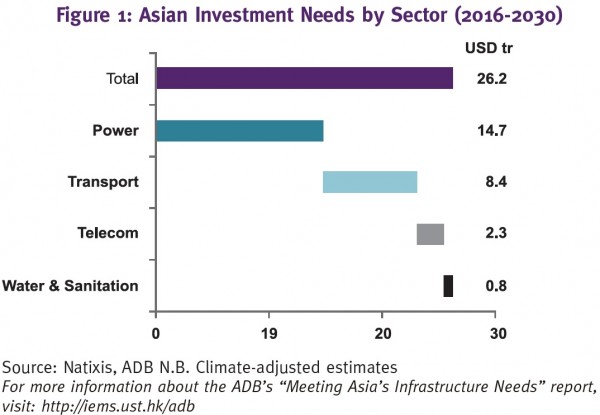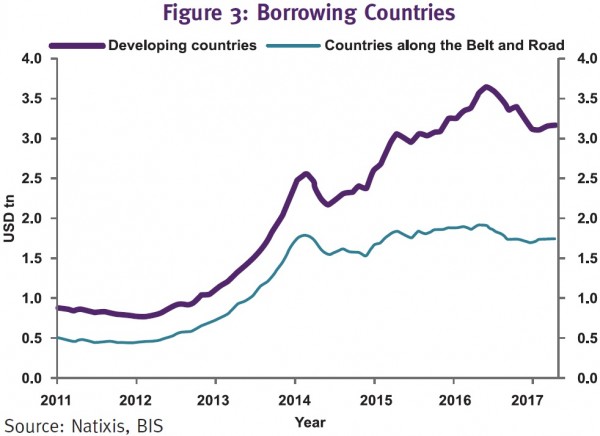China Cannot Finance the Belt and Road Alone
HKUST IEMS Thought Leadership Brief No. 17
SHARE THIS

Key Points
- The Belt and Road Initiative holds great promise for the global economy, but will need a huge amount of finance.
- Initial presumptions that China would be able to provide all the finance are now unrealistic.
- Other partners should consider providing finance for some aspects, especially Europe which has a lot to gain from the project.
Issue
There is no doubt that Asia needs infrastructure. The Asian Development Bank (ADB) recently increased its already very high estimates of the amount of infrastructure needed in the region to USD 26 trillion in the next 15 years, or USD 1.7 trillion per annum (Figure 1). Luckily, the China-driven Belt and Road initiative aims to address that pressing need, especially in transport and energy infrastructure. But this is easier said than done. Intuitively, we would like to believe that the financing will be there thanks to China’s massive financial resources.
Chinese authorities have come up with their own estimates of the projects that will be financed-starting at USD 1 trillion and reaching USD 5 trillion in only 5 years. In the same vein, the official list of countries does nothing but increase over time to more than 65 countries today.
But there is a limit to how much China can finance. China’s ability to finance the Belt and Road was more believable before 2015, when the Chinese economy was flooded with capital inflows, with reserves nearly reaching USD 4 trillion. There was certainly a need for diversification. Coincidentally, Chinese banks were then improving their asset quality-if anything, because the economy was booming and bank credit was growing at double digits.
The situation today is very different. China’s economy has slowed down, and banks’ balance sheets are saddled with doubtful loans. What is worse, banks keep on refinancing these loans, not leaving much room for the massive lending needed to finance the Belt and Road initiative. The debt-burden faced by Chinese banks is particularly important for the Belt and Road, as Chinese banks have been the largest lenders so far (China Development Bank lending an estimated USD 100 billion while Bank of China has already committed to USD 20 billion in loans). Sadly, the burden falls mostly on the shoulders of Chinese banks as the multilateral organizations geared towards financing the Belt and Road certainly do not have such financial muscle. Even the Asian Infrastructure Investment Bank (AIIB), founded for this very purpose, has so far only invested USD 1.7 billion on Belt and Road projects.
As if China’s corporate indebtedness were not worrying enough, China has lost nearly USD 1 trillion in foreign reserves due to massive capital outflows. Even though USD 3 trillion of reserves could still look ample, the Chinese authorities seem to have set that level as a floor under which reserves should not fall, in a bid to restore confidence (Figure 2). This obviously does not give much leeway for China to finance Belt and Road projects, at least in hard currency. Against this backdrop, we can consider different financing options for Xi’s Grand Plan as well as their implications.


Assessment
The first way China can finance the Belt and Road is also the least likely: China can continue to finance the massive project unilaterally.
Unilateral financing is particularly difficult if hard-currency financing is needed, for the indebtedness reasons mentioned above. China could still opt for lending in RMB, at least partially, with the side-benefit of pushing RMB internationalization. However, even this is becoming more difficult.
First, the use of the RMB as an international currency has been decreasing because of stock market corrections and currency devaluation in 2015. Yet the RMB can still be used to finance some Belt and Road projects as long as borrowing countries are fully devoted to pay Chinese energy or construction companies. This quasi-barter system can solve the hard-currency constraint but poses its own risks to the over-extended balance sheets of Chinese banks. In fact, their doubtful loans have only multiplied during the last few years, eating up space that banks’ have for more loans.
A second option is for China to intermediate overseas financial resources for the Belt and Road projects.
The most obvious way to do this is to borrow from international banks, prudent given the limited development of bond markets in Belt and Road countries, as well as the still-limited size of China’s own offshore bond market. In fact, cross border bank lending has been a huge pool of financial resources, especially in the run up to the global financial crisis. China has since toned down international borrowing, but the stock of cross border lending still hovers above USD 15 trillion, nearly half of which is lent by European banks. Out of the USD 15 trillion, about 20% is already being directed to Belt and Road economies, again with European banks the largest players.
Still, to finance the USD 5 trillion targeted in Xi’s grand plan for the next five years, we would need to see growth rates of around 50% in cross-border lending. While such a surge in cross-border lending is not unheard of (in fact, it happened in the years prior to the global financial crises), the real bottleneck would be the rapid increase in China’s external debt. Even if co-financed by Belt and Road countries, China may end up with external debt ballooning from a comfortable 12% of GDP to over 50%.
A mix of options 1 and 2 relies on the use of multilateral development banks to finance the Belt and Road projects. Understandably, China is a major shareholder of its newly created multilateral banks (AIIB and New Development Bank), yet China is less so in existing ones (such as ADB, EBRD or the World Bank). China’s involvement means that the burden of financing can be shared with other creditors, while keeping a tight grip on the construction of such infrastructure (at least in the case of the new, China-led organizations). While seemingly perfect, the problem with this option is that the capital available to these institutions will not cover the Belt and Road’s financing needs (Figure 4).


Recommendations
In the end, it seems that China cannot rely on its banks alone – no matter how massive – to finance the gigantic Belt and Road plan. Logically, the best source of co-finance would be Europe, at least if bank lending dominates (which will be the case for quite some time in the Belt and Road countries). Already, European banks are the largest providers of cross-border loans to Belt and Road countries, so it is only a question of encouraging that trend. Furthermore, the geographical proximity between Europe and some of the Belt and Road countries could make the projects much more appealing. In addition, the European Union has its own grand plan for financing infrastructure (among other sectors), namely the Juncker Plan, which could serve as a basis to identify joint projects of interest to both the EU and China. In the spirit of mutual interests, the EU-China connectivity platform was launched by the European Commission in late 2015 exactly to identify projects of common interest between the Belt and Road and the EU connectivity initiatives (such as the Trans-European Transport network). All of this bodes well for Europe, to become an active actor in China’s Belt and Road initiative—not only providing financing, but also to identify projects of common interest.
The advantages to be had by Europe in Belt and Road projects should make Europe a leader in financing them, bringing the old continent closer to China.
It goes without saying that other lenders, beyond Europeans, would be welcome to finance Belt and Road projects, as the ensuing reduction in transportation costs and improved connectivity should benefit the world as a whole.
Under this gigantic infrastructure plan, Hong Kong is perfectly placed to play an increasingly significant role in external financing. First, Hong Kong has long been the world’s gateway to China. Hong Kong is a major offshore center at global scale. Beyond its ability to raise capital through its stock market, Hong Kong also has a large banking sector from which major international banks lend. In fact, total cross-border bank lending from Hong Kong to the rest of the world stood at USD 2.7 trillion by the end of 2016 according to the Bank of International Settlements. Hong Kong’s potential to support the Belt and Road is already translating into action, starting with the recent announcement by regulators that they will ease the listing conditions for firms linked to the Belt and Road as well as the Infrastructure Financing Facilitation Office (IFFO) established by the Hong Kong Monetary Authority to support investors. The recently established Hong Kong Bond Connect could also become a useful tool for China to attract foreign capital to finance Belt and Road projects.
About the author
Alicia Garcia-Herrero is Chief Economist for Asia Pacific at NATIXIS and a HKUST IEMS Faculty Associate. Alicia has held positions in several central banks, retail banks and NGOs, most notably the IMF. Alicia works with think-tanks such as BRUEGEL, Real Instituto El Cano and the Emerging Market Institute at the Johnson Graduate School of Management. She is a member of the Council of Advisors of the HK Institute for Monetary Research, an adjunct professor at HKUST and a visiting faculty at the China-Europe International Business School.
Related Video
In an earlier interview with HKUST IEMS, Prof Garcia-Herrero compared the Belt and Road Initiative to the Marshall Plan, and suggested that the initiative is China’s way of carving out an economic and geo-political bloc for itself, with clear implications for RMB internationalization.
Acknowledgment
This research is supported by the Strategic Public Policy Research Funding Scheme from the Central Policy Unit of the HKSAR Government. More >>
Get updates from HKUST IEMS






